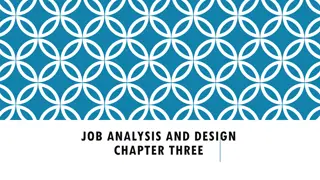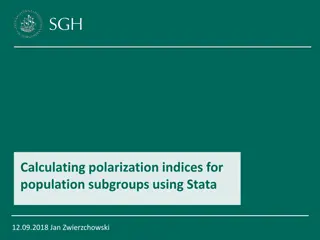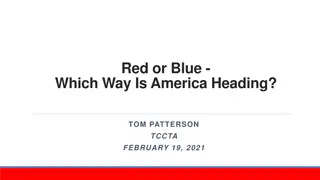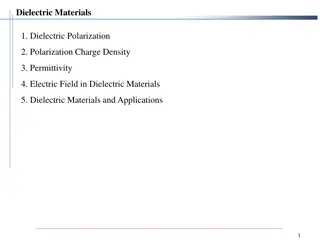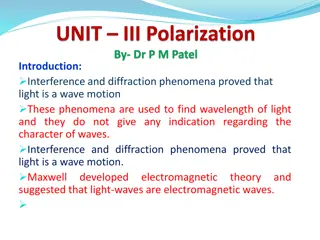Trends in Job Polarization
Job polarization refers to the shifting distribution of jobs based on occupations, skill levels, and educational backgrounds. This trend is evident in the reduction of mid-skilled jobs and the increase in low-skilled and high-skilled employment, impacting income inequality. Some mid-skilled occupations, like sales and service, have seen growth while others, notably in manufacturing, have declined. Understanding these dynamics is crucial for policymakers and economists to address the evolving job landscape and its implications for society.
Download Presentation

Please find below an Image/Link to download the presentation.
The content on the website is provided AS IS for your information and personal use only. It may not be sold, licensed, or shared on other websites without obtaining consent from the author.If you encounter any issues during the download, it is possible that the publisher has removed the file from their server.
You are allowed to download the files provided on this website for personal or commercial use, subject to the condition that they are used lawfully. All files are the property of their respective owners.
The content on the website is provided AS IS for your information and personal use only. It may not be sold, licensed, or shared on other websites without obtaining consent from the author.
E N D
Presentation Transcript
Trends in Job Polarization Sosina Bezu April 21, 2021
What is job What is job- -polarization? polarization? Job polarization describes the changing distribution of jobs according to different occupations, skill levels and educational backgrounds Overall trend by skill (OECD): Reduction in share of employment in mid-skilled occupations Corresponding increase in share of low-skilled and high-skilled employment Partly explained by stagnation in manufacturing employment, but changes observed beyond manufacturing Fewer demand for mid-skilled workers Trend indicate a U-shaped economy
Percentage point change in share of total employment by skill level, 1995 to 2015 Percentage point change in share of total employment by skill level, 1995 to 2015 (OECD employment outlook 2017) (OECD employment outlook 2017) OECD Countries Low-Skilled Jobs Mid-Skilled Jobs High-Skilled Jobs Austria 3 -16.8 13.8 Switzerland 0 -15.6 15.6 Ireland Spain Greece Denmark France Sweden Portugal 0.7 3.4 8.7 4.5 4.1 3 2.7 -15.1 -13.6 -13.2 -12.7 -12.1 -11 -10.7 14.4 10.2 4.5 8.2 8 8 8 United Kingdom 1.1 -10.2 9.1 Norway 3.9 -10 6.1 Netherlands 4.2 -9.7 5.5 Finland Italy Germany Belgium 0.8 4.6 3.4 1.4 -9.7 -9.3 -8.2 -7.3 8.9 4.8 4.7 6 United States 1.2 -6.6 5.3 Slovenia -2.3 -6.5 8.8 Slovak Republic 0.9 -5.4 4.5 Japan Hungary 2.6 -5 -5.2 -2.5 2.5 7.5 Czech Republic -5 -2.1 7.1 Canada TOTAL 1.8 1.9 -6.2 -9.5 4.3 7.6
Job polarization in Canada, 1989-2019 60.0% Employment share, mid- skilled jobs declined from 58.5% to 52.6% Employment share of high- skilled jobs increased by 7.5- percentage-point Low-skilled employment share declined by 1.6 percentage point 50.0% Employment Share 40.0% 30.0% 20.0% 10.0% 0.0% High-skilled jobs Mid-skilled jobs Low-skilled jobs 1989 2019
Some mid Some mid- -skilled occupations fare better than others skilled occupations fare better than others Not all mid-skill occupations are shrinking Mid-skilled manufacturing jobs declined Mid-skilled sales and service occupations increased Mid-skilled health occupations also experience increased dd. Growing and shrinking occupations (Mid-skill jobs) 3000 2500 2000 1500 1000 500 0 1989 1991 1993 1995 1997 1999 2001 2003 2005 2007 2009 2011 2013 2015 2017 2019 Sales and service occupations Occupations in manufacturing and utilities
Job polarization and increased income inequality Job polarization and increased income inequality High-skilled workers earn 4 times that of low-skilled workers 16K vs 60K More job-polarization lead to higher income inequality Some Canadians more affected: Recent immigrants and youth over-represented in low-skilled employment Median employment income 60000 50000 40000 30000 20000 10000 0 Low-skilled jobs Mid-skilled jobs High-skilled jobs
Policy considerations How to create a new generation of middle-class jobs This can t be about bringing coal back . Nature of work has changed and creative thinking needed to transition current low-skilled jobs to mid-skilled occupation Investing in workers upskilling to help them catch up with technological changes Some industries are experiencing both shortage of skilled workers (for technology intensive roles) and have fewer positions for mid-skilled roles Credential recognition (for internationally educated), labour market standards (eg. Gig economy), etc to protect the vulnerable


